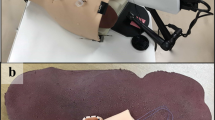Abstract
Purpose
We verified the appropriate port location for laparoscopic hepaticojejunostomy using a comprehensive laparoscopic training simulator.
Methods
We developed a hepaticojejunostomy model, consist of common hepatic duct and intestine and participants required to place two sutures precisely using two different port locations (A: standard port location, B: modified port location). The order of tasks was randomly determined using the permuted block method (Group I: Task A → Task B, Group II: Task B → Task A). The time for task completion and total number of errors were recorded. In addition, we evaluated the spatial paths and velocity of both forceps. Statistical analyses were performed using a statistical software program.
Results
The time for the task, the total error score, and the spatial paths and velocity of both forceps were not significantly different between groups I and II. Furthermore, the port location and order of tasks (group I or group II) did not significantly affect the results. In contrast, there were significant differences in the performance between experts and novices, who were classified as such based on the total number of experienced endoscopic surgeries.
Conclusion
Preoperative port simulation in advanced surgery using our artificial simulator is feasible and may facilitate minimally invasive surgery for children.




Similar content being viewed by others
References
Tomikawa M, Uemura M, Kenmotsu H, Konishi K, Ohuchida K, Okazaki K, Ieiri S, Tanoue K, Hashizume M (2015) Evaluation of the 10-year history of a 2-day standardized laparoscopic surgical skills training program at Kyushu University. Surg Today. doi:10.1007/s00595-015-1227-y
Alain JL, Grousseau D, Longis B, Ugazzi M, Terrier G (1996) Extramucosal pyloromyotomy by laparoscopy. J Laparoendosc Surg 6(Suppl 1):S41–S44
Holcomb GW 3rd, Olsen DO, Sharp KW (1991) Laparoscopic cholecystectomy in the pediatric patient. J Pediatr Surg 26(10):1186–1190
Rothenberg SS (2005) Thoracoscopic repair of esophageal atresia and tracheo-esophageal fistula. Semin Pediatr Surg 14(1):2–7
Diao M, Li L, Cheng W (2013) Role of laparoscopy in treatment of choledochal cysts in children. Pediatr Surg Int 29(4):317–326
Jimbo T, Ieiri S, Obata S, Uemura M, Souzaki R, Matsuoka N, Katayama T, Masumoto K, Hashizume M, Taguchi T (2015) Effectiveness of short-term endoscopic surgical skill training for young pediatric surgeons: a validation study using the laparoscopic fundoplication simulator. Pediatr Surg Int 31(10):963–969. doi:10.1007/s00383-015-3776-y
Obata S, Ieiri S, Uemura M, Jimbo T, Souzaki R, Matsuoka N, Katayama T, Hashizume M, Taguchi T (2015) An endoscopic surgical skill validation system for pediatric surgeons using a model of congenital diaphragmatic hernia repair. J Laparoendosc Adv Surg Tech A (In press)
Yamataka A, Lane GJ, Cazares J (2012) Laparoscopic surgery for biliary atresia and choledochal cyst. Semin Pediatr Surg 21(3):201–210. doi:10.1053/j.sempedsurg.2012.05.011
Urushihara N, Fukumoto K, Nouso H, Yamoto M, Miyake H, Kaneshiro M, Koyama M, Nakajima H (2015) Hepatic ductoplasty and hepaticojejunostomy to treat narrow common hepatic duct during laparoscopic surgery for choledochal cyst. Pediatr Surg Int 31(10):983–986. doi:10.1007/s00383-015-3779-8
Ieiri S, Nakatsuji T, Higashi M, Akiyoshi J, Uemura M, Konishi K, Onimaru M, Ohuchida K, Hong J, Tomikawa M, Tanoue K, Hashizume M, Taguchi T (2010) Effectiveness of basic endoscopic surgical skill training for pediatric surgeons. Pediatr Surg Int 26(10):947–954
Lee JH, Kim SH, Kim HY, Choi YH, Jung SE, Park KW (2013) Early experience of laparoscopic choledochal cyst excision in children. J Korean Surg Soc 85(5):225–229. doi:10.4174/jkss.2013.85.5.225
Hopper AN, Jamison MH, Lewis WG (2007) Learning curves in surgical practice. Postgrad Med J 83(986):777–779. doi:10.1136/pgmj.2007.057190
Uemura M, Tomikawa M, Kumashiro R, Miao T, Souzaki R, Ieiri S, Ohuchida K, Lefor AT, Hashizume M (2014) Analysis of hand motion differentiates expert and novice surgeons. J Surg Res 188(1):8–13
Beyer-Berjot L, Palter V, Grantcharov T, Aggarwal R (2014) Advanced training in laparoscopic abdominal surgery: a systematic review. Surgery 156(3):676–688
Botden SM, Goossens R, Jakimowicz JJ (2010) Developing a realistic model for the training of the laparoscopic Nissen fundoplication. Simul Healthc 5(3):173–178
Acknowledgments
We thank Brian Quinn for his comments and help with the manuscript. This study was supported by Grants-in-Aid for Scientific Research from the Japan Society for the Promotion of Science (JSPS, No. 15K01355) and the Japanese Foundation for Research and Promotion of Endoscopy (JFE).
Author information
Authors and Affiliations
Corresponding author
Ethics declarations
Conflict of interest
No competing financial interests exist.
Rights and permissions
About this article
Cite this article
Jimbo, T., Ieiri, S., Obata, S. et al. Preoperative simulation regarding the appropriate port location for laparoscopic hepaticojejunostomy: a randomized study using a disease-specific training simulator. Pediatr Surg Int 32, 901–907 (2016). https://doi.org/10.1007/s00383-016-3937-7
Accepted:
Published:
Issue Date:
DOI: https://doi.org/10.1007/s00383-016-3937-7




